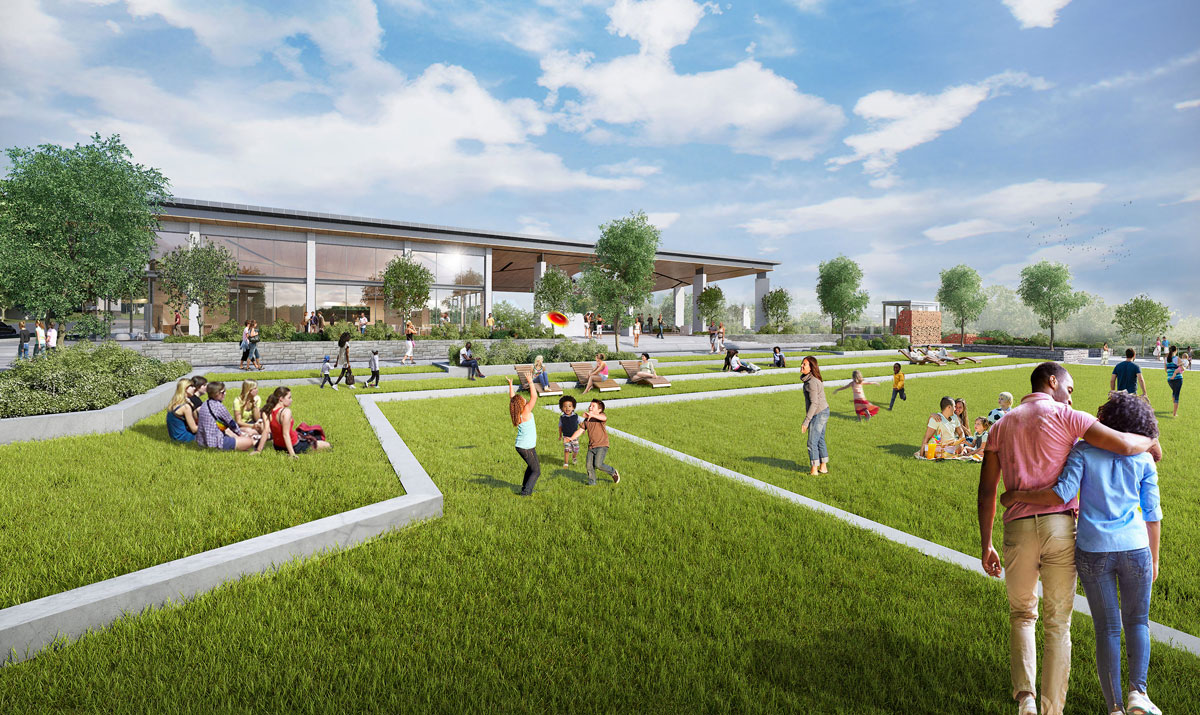
A new parking deck in Grant Park will be smart, convenient, and aesthetically appealing for neighboring homes. [Rendering: Courtesy of Smith Dalia Architects and Winter Johnson Group]
LOCATION: Atlanta SIZE: Approximately 434,000 square feet COST: $48 million COMPLETION: Late 2019 ARCHITECT: Smith Dalia Architects LANDSCAPE ARCHITECT: HGOR GENERAL CONTRACTOR: Winter Johnson Group STRUCTURAL ENGINEER: Sykes Consulting, Inc.
It was a tall order from city leaders when they solicited for a design team to create a plan for a new parking deck in Grant Park. Home to Zoo Atlanta, the city’s oldest traditional park is one of the area’s most popular destinations with more than a million visitors annually. The new structure had to be smart, convenient, and aesthetically appealing for neighboring homes—a typical above-grade, cement monstrosity wouldn’t do. Plus, like all new construction in Georgia’s capital city, the structure needed to be at least LEED Silver certified while simultaneously increasing parking capacity, incorporating the latest technology, and most importantly, blending seamlessly into the natural landscape.
While, on its face, a parking garage may pale in comparison to some projects in a firm’s portfolio, what Atlanta’s leaders had in mind was anything but ordinary—and the experts at Smith Dalia Architects were up to the challenge and gladly accepted the award to design the Grant Park Gateway Project.
From Gray to Green
Along with HGOR landscape architects and general contractors Winter Johnson Group, Smith Dalia’s design marries the city’s and Zoo Atlanta’s needs with neighboring residents’ wishes. Today, homes overlook a sprawling concrete parking lot, visitors circle endlessly looking for a parking spot, and storm water runoff is always an issue. Once complete, the new three-tier, 1,000-space parking deck will feature electric car charging stations and a smart parking system that detects space availability. But even more importantly, the structure is being built into the existing hillside along Boulevard Avenue and will boast a rooftop green space with a restaurant, bicycle parking, new pedestrian pathways, and a 67,000-gallon cistern for collecting and reusing rainwater. The new design takes equal measures to correct current erosion issues, and even the façade that is visible won’t be concrete. “Basically, we’re converting an 8-acre surface parking lot into a multi-level, multi-purpose parking garage, transforming the fourth level into a 7-acre green space that will be fundamentally different from the rest of the park while still connecting the park to the community,” explains Amy Phuong, commissioner for the City of Atlanta’s Department of Parks and Recreation

[Rendering: Courtesy of Smith Dalia Architects and Winter Johnson Group]
A Sustainable Future
Thoughtful consideration was given, too, to the parking deck’s long-term usability. “There was this classic conversation that, in 50 years, what do you do with a multi-level parking garage,” Phuong recalls. So the parking deck was designed so that, if desired, the next generation of leaders can easily convert the structure into another facility based on its intelligent design and construction.
The Grant Park Gateway Project broke ground in spring 2018 and completion is expected in 2019. “Atlanta wants to be a top-tier sustainable city, and our leaders have made major strides toward that goal,” Phuong says. The Parks and Recreation team traveled to Dallas to study the nationally renowned Klyde Warren Park, an urban green space known for its innovative design over a recessed freeway. That’s where the idea for Grant Park’s green roof and restaurant were born. Phuong’s team also visited a parking garage project in a community near Dallas Arboretum to gather notes on its unique design and smart technology.
The greatest challenge so far for the Grant Park project has revolved around community support, particularly around blending the new parking deck into the existing landscape. The design-build method has been a hard delivery method to explain. Community input and design decisions were made early in the planning process, and now that the project is underway, it’s taken some by surprise. It has also proven challenging to convince the community that the city is, in fact, going to deliver what it promised—that is, a sustainable, engaging green space. Tree loss has been a controversial topic. Minimizing the number of trees lost is key. Phuong says, “For every tree impacted, a new tree will be replanted as part of the green roof or throughout the rest of the park.”
